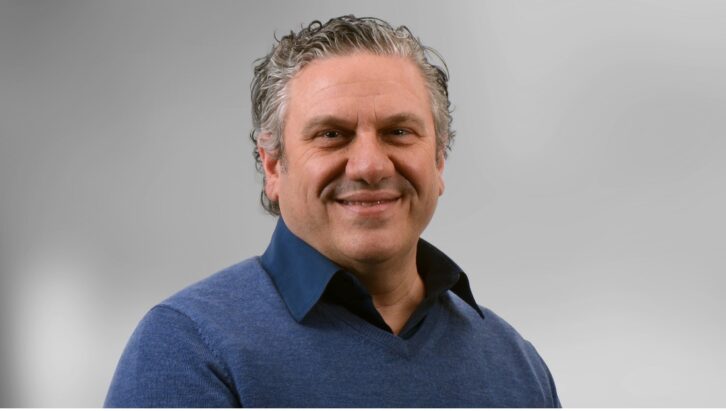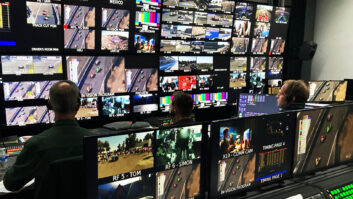The broadcast industry has undergone fundamental change in recent years, driven by the adoption of SMPTE ST 2110, the rise in popularity of remote production, and the arrival of generative AI.
TVBEurope caught up with Alberto Cieri, SVP, global sales and marketing at Matrox Video, to discuss changes within the industry, and why he feels we’re currently in a time of transition.
Matrox Video has been operating in the media and entertainment industry for a number of years. How have you seen the industry change over that time?
Significant transformations within the media and entertainment industry have consistently been shaped by both technological advancements and changing consumer behaviours.
In the past, the move to digital processes not only empowered media organisations to enhance the quality of content but also enabled them to improve overall efficiency and accessibility with more streamlined workflows. In more recent times, another notable shift has been the industry’s adoption of ST 2110/IP, which has enabled even more efficient and flexible content production and distribution.

The emergence and increasing ubiquity of the internet, and later the rise of social media, streaming services, and mobile devices, has been transformational, even disruptive, in a different sense. This shift has not only altered the demand-supply patterns typical within traditional broadcast business models but also fundamentally redefined how and where audiences access and consume content. Online platforms and mobile devices now play a pivotal role in content consumption.
Ongoing advances in capture and display technology — such as 4K, 8K, and HDR — are contributing to the creation of more immersive entertainment experiences, setting new standards for visual quality.
Remote production and live cloud production have likewise emerged as transformative elements, allowing for more flexible and cost-effective content creation, catering to the demands of an ever-changing market.
Meanwhile, in response to market need, standards and solutions are evolving to support integration of pro-AV gear into broadcast workflows. Standards like IPMX, a derivative of ST 2110, are playing an essential role in this process. Looking ahead, I anticipate that the expansion of IPMX into the broadcast domain will pave the way for increased adoption of pro-AV gear, further enhancing the capabilities and versatility of content production and delivery.
How stable do you see the industry at the moment?
Right now, there is a noticeable surge in the industry’s movement toward the cloud. And what makes this period particularly intriguing is the concerted effort on the part of broadcasters and other media companies to define what it means for them to move to the cloud. With respect to stability, I’d say that though this is a time of transition, companies are asking the right questions. How can we distribute the workload? How can we be resilient enough to protect our workflows? These inquiries naturally lead to a pivotal realisation: It’s necessary to become more software-centric.
With this understanding has come broad acknowledgment among media companies that flexibility is of the utmost importance, and the optimal way to achieve that flexibility is to pair standard IT equipment with software that solves a specific problem.
What do you view as the biggest fundamental change within the industry in recent years?
The most significant fundamental change has been the transition from traditional broadcast infrastructure to ST 2110 and IP-based systems. This shift has ushered in a new era of flexibility, scalability, and efficiency in content production and distribution. Notably, it has also been central to development and adoption of remote production, making this model more cost-effective and responsive to the dynamic needs of the industry.
The adoption of ST 2110 is on a steady rise, particularly in sports and entertainment venues. A standout in this trend is the Sphere in Las Vegas, unveiled in 2023 during U2’s UV Achtung Baby Live at Sphere residency, boasting a complete ST 2110 backbone. Matrox Video takes pride in contributing to this evolution with our ConvertIP and ConductIP products, which simplify setup and management of ST 2110. The trend of ST 2110 adoption in US venues is expected to escalate, and we predict that all these venues will eventually update their equipment to embrace ST 2110.
Another transformative shift is the migration of workflows to the cloud and software. Already facilitating the rise of remote production, this change is certain to result in more personalised content production, as the cloud allows for flexible workflows that can be tailored to specific coverage or monetisation strategies. This capability enables the delivery of live events to each viewer in a way that caters precisely to their interests. Embracing the full potential of the cloud is integral to adapting to this evolving landscape, allowing the industry to produce content in a more dynamic and strategic manner.
SMPTE ratified 2110 back in 2017 and it’s sort of stayed the same ever since. What’s the next step for IP?
Many facilities are still in the process of migrating from legacy infrastructure to IP-based solutions, which involves not only upgrading equipment but also training staff and ensuring interoperability. While the ratification of SMPTE ST 2110 marked a pivotal moment in the industry’s trajectory toward IP-based solutions and workflows, the next steps for IP involve a multifaceted approach with three main aims: broader adoption, integration into existing workflows, and continuous refinement to meet evolving industry needs.
While implementations of ST 2110 in its initial phases of adoption were complicated by the need for traditional broadcast engineers, largely accustomed to SDI workflows, to acquire a new knowledge base centered in networking, times have changed. We’ve since seen a significant shift in talent and skills developed by broadcast personnel across the industry. This evolution has contributed to a more accessible setup for high-end ST 2110 environments, with approximately 30 per cent year-over-year growth in adoption by tier 1 and tier 2 broadcast facilities.
Looking forward, I am confident the industry will continue to refine and evolve IP standards. This evolution may involve updates and extensions to ST 2110 to accommodate new requirements, such as higher resolutions and more efficient compression.
Remote production will become even more efficient and widespread, increasingly leveraging IP for remote contribution, monitoring, and control with lower latency and a better overall user experience. IP also will be key in facilitating the migration of workflows to cloud-based infrastructures. This shift will bring much improved flexibility and scalability, supporting with the industry’s ongoing quest for more dynamic and responsive content creation environments.
As sustainability gains prominence, IP technology can contribute significantly to reducing the carbon footprint of media and entertainment operations. By enabling more efficient data transfer and centralised resource management, IP-based solutions align with the industry’s commitment to environmentally conscious practices.







